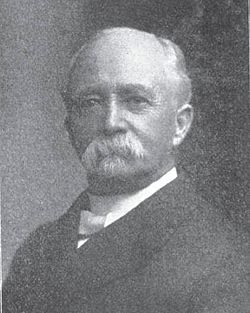Angus Munn Cannon (May 17, 1834 – June 7, 1915) was an early Latter Day Saint leader and Mormon pioneer.

Early life
editCannon was born in Liverpool, Lancashire, England. His Manx parents joined the Church of Jesus Christ of Latter Day Saints in 1840, being baptized by his uncle John Taylor.[1]
In 1842, the Cannon family went to Nauvoo, Illinois, United States. By 1849, they were in Utah Territory. Cannon was the younger brother of George Q. Cannon and their lives followed very similar paths up until their arrival in Utah.
Church service
editIn 1854, Cannon went on a mission for the Church of Jesus Christ of Latter-day Saints (LDS Church) to the Eastern United States, where he assisted John Taylor in publishing a periodical entitled The Mormon. He also preached and baptized in Connecticut, New Jersey, Pennsylvania and Delaware.[2] Cannon returned to Utah Territory due to the troubles connected with the Utah War.
In 1864, Cannon helped establish Call's Landing on the Colorado River, later known as Callville, Nevada. Callville was submerged when Lake Mead was filled.
In 1869 and 1870, Cannon served a second mission in the Eastern United States.[3] In April 1876, Cannon became president of the Salt Lake Stake of the LDS Church. He served in this position until April 1, 1904.[4] This stake was the largest and most important stake of the Church at the time, often considered to be the "flagship stake" of the Church, which made Cannon the most important stake president of the time. After his time as stake president, Cannon served as a patriarch in the church.
Politics
editCannon was the mayor of St. George, Utah Territory in 1861 and 1862. In 1896, after Utah had become a U.S. state, he stood for election as the Republican Party candidate for a state senate seat in Salt Lake County. He was defeated by one of his wives, Martha Hughes Cannon, who was the Democratic Party candidate.
Polygamy prosecution
editLike many early members of the LDS Church, Cannon practiced plural marriage. Cannon was the appellant in the case of Cannon v. United States, which was decided by the United States Supreme Court in 1885.[5] Cannon had been convicted under the Edmunds Act of unlawful cohabitation with more than one wife and sentenced to six months' imprisonment and a $900 fine.[6] Cannon appealed his conviction on the grounds that he had immediately ceased having sexual relations with the two wives he was accused of cohabiting with after polygamy was criminalized.[5] The Court rejected Cannon's argument, holding that "[c]ompacts for sexual non-intercourse, easily made and easily broken, when the prior marriage relations continue to exist, with the occupation of the same house and table and the keeping up of the same family unity, is not a lawful substitute for the monogamous family which alone the statute tolerates."[5]
Cannon was pardoned in 1894 by U.S. President Grover Cleveland.[7]
Death
editCannon died of "apoplexy" in Salt Lake City, Utah.[8]
See also
editReferences
edit- ^ Cannon, Donald Q., "Angus M. Cannon: Pioneer, President, Patriarch" in Cannon, Donald Q. and David J. Whittaker, ed., Supporting Saints: Life-Stories of 19th Century Mormons. (Salt Lake City: Bookcraft, 1985) p. 370
- ^ Cannon. Supporting Saints. p. 371
- ^ Cannon. Supporting Saints. p. 372
- ^ Cannon. Supporting Saints. p. 372, 386
- ^ a b c 116 U.S. 55 (1885).
- ^ "The Anti-Polygamy Law; Ex-Delegate Cannon's Sentence Affirmed. The Supreme Court Upholds the Decisions of the Territorial Judges; Opinions in Other Cases", The New York Times, December 15, 1885.
- ^ "Archived copy". Archived from the original on October 8, 2018. Retrieved November 24, 2014.
{{cite web}}: CS1 maint: archived copy as title (link) - ^ State of Utah Death Certificate Archived July 18, 2011, at the Wayback Machine
Further reading
edit- Cannon, Donald Q. (1985). "Angus M. Cannon: Pioneer, President, Patriarch". In Donald Q. Cannon; David J. Whittaker (eds.). Supporting Saints: Life Stories of Nineteenth-Century Mormons. Religious Studies Center Specialized Monograph Series. Vol. 1. Provo, Utah: Religious Studies Center, Brigham Young University. pp. 369–402. ISBN 0-88494-565-0.